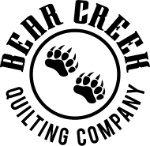About Fabric - Batik, Quilter's Cotton, and Flannel
|
 |
|
About Batiks To make batik fabrics, areas of the fabric are blocked out with the application of a hot wax “resist”, then the fabric is dyed. The pattern covered in wax resist the dye, leaving unique designs after repeat waxing and dyeing. After each dyeing, the fabric is carried by hand outside to dry in the sun. Once dry, it is carried back inside. The fabric is then boiled and dried to remove the wax and excess dye. The process of applying wax resist, dying, drying in the sun, boiling, and drying in the sun again is repeated until the desired design is complete. The three most common methods of applying the resist to the fabric are:
Tjaps are the method of choice for most large manufacturers because they are faster to use. Once a design has been approved for production, a metal artist makes the tjap. A tjap is made of copper pieces arranged on a handle in the desired design. Each yard of fabric can have 9 to 12 different sets of the imprint. Dyeing techniques can include dyeing with a single color, hand painting, and/or treating the fabric with sea salt or urea (a common fertilizer) to produce unique patterns. This process originated in Indonesia and today most batik fabric is still made there. Because they are very labor intensive to produce, batiks usually cost more than printed fabrics. The whole process of creating batik fabric, 2000 years old, is still done completely by hand. |
|
Did you know? The word 'batik' is derived from the Javanese (native language of Java, an Indonesian island) word called 'ambatik' where 'amba' means 'large,' and 'tik' means 'dot.' |
|
About Flannel Flannel is a soft, loosely woven, and slightly napped fabric used for a wide range of garments. Originally made from carded wool or worsted yarn, it is now made from a wide variety of fibers. Flannel can be brushed to create extra softness or remain ‘un-brushed’. Brushing is a mechanical process wherein a metal brush rubs the fabric to raise fine fibers from the loosely spun yarns to form a nap on one or both sides. Wool fabrics, which must be damp when brushing, are then dried and stretched before the nap is trimmed or sheared. Cotton goes straight to the shearing process, where the nap gets trimmed to ensure that all the raised fibers are the same length. Flannel fabric is known for being:
|
|
Did you know? Flannel has even been composed of fibers from the Scots pine. “Vegetable flannel” was invented by Léopold Lairitz in Germany in the 1800’s! |
|
About Quilter’s Cotton Threads per inch, weight of the thread, and staple (length, of cotton fiber used in the thread) all affect the final fabric. Quilter’s Cotton typically has more threads per inch, a longer staple thread, a finer weight of thread than other cottons. This makes a strong, sturdy, but still soft fabric, typically of a medium stiffness. This material is the most popular for quilting because it doesn't stretch during sewing, won’t shrink in the wash, and holds up through washes. Due to the higher thread count and denser weave, Quilter’s Cotton weighs more than apparel cotton. For example, quilting cotton usually weighs at least four ounces per square yard. Apparel cotton such as cotton lawn only weighs two to three ounces per square yard. |
|
Did you know? Cotton is the oldest known textile, with documented use dating back as far as 6000 BCE in Peru! |
|
Free Downloadable PDF is available HERE |
 and the BCQC Team |


